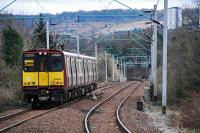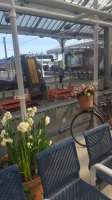This day in history 27 March
Images
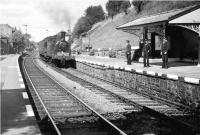
Clarkston for Eaglesham: A train for Busby arrives at Clarkston on 27 March 1949 behind ex-Caledonian 0-4-4T 15183.
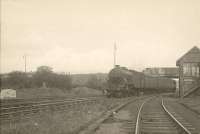
Whiteinch Victoria Park: V1 2.6.2T 67619 approaching. Whiteinch (Victoria Park) 27.3.51 - closed 31.3.51.
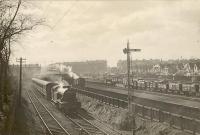
Whiteinch Victoria Park: 67631 running round. 67619 at other platform. Whiteinch (Victoria Park) 27.3.51 - closed 31.3.51.
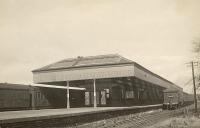
Whiteinch Victoria Park: V1 2.6.2T 67631 arriving. Whiteinch (Victoria Park) 27.3.51 - closed 31.3.51.
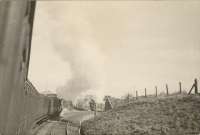
Whiteinch Victoria Park: 67631 climbing up to Jordanhill. Whiteinch (Victoria Park) 27.3.51 - closed 31.3.51.
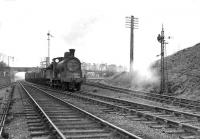
Clarkston and Stamperland: 57564 approaching Clarkston with a coal train in July 1954.
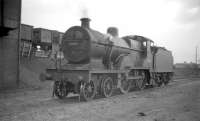
Ardrossan Shed [GSW] [2nd]: Fowler 2P 4-4-0 no 40667 stands in the shed yard at 67D Ardrossan in March 1959.
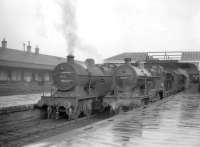
Kilmarnock: A pair of Hurlford shed's Fowler 2P 4-4-0s nos 40661 and 40689 wait with their trains in the bays at the north end of Kilmarnock station on 27 March 1959. On the left is the 4.16pm to Glasgow St Enoch and on the right the 4.13pm to Ayr. Both locomotives had been withdrawn by the end of 1960.

Ardrossan Shed [GSW] [2nd]: 57673 on shed at 67D Ardrossan on 27 March 1959. The locomotive was withdrawn from here in March 1962 and Ardrossan shed closed in February 1965. See image [[1036]]
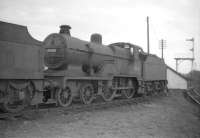
Ardrossan Shed [GSW] [2nd]: Fowler 2P 4-4-0 no 40606 stored at 67D Ardrossan shed in March 1959. Officially withdrawn by BR two months later, the locomotive was cut up at Inverurie works at the end of September that year.
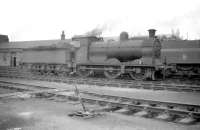
Hurlford Shed: McIntosh 3F 0-6-0 no 57643 simmers in the shed yard at Hurlford in March 1959.
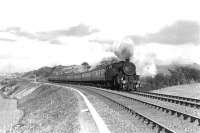
Neilston High: Fairburn tank 42059 has just run past the up distant for Neilston on 27 March 1962 with the 5.42pm Glasgow Central - Uplawmoor train. [Ref query 7522]
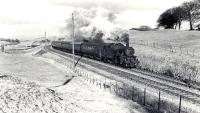
Shilford Summit: Fairburn tank 42056 passing Shilford with the 5.12pm Glasgow - Uplawmoor train on 27 March 1962. The joint line can be seen top left passing through Shilford Gap at the top of Neilston bank.

Ruchill Goods: Class J37 0-6-0 no 64623 stands in the sidings at Ruchill with a BLS brake van tour on 27 March 1964, the year before closure. The short NB freight-only branch left the GD&H route just west of what is now Possilpark and Parkhouse station. Brassey Street bridge spans the line in the background and the houses of Curzon Street stand top left.
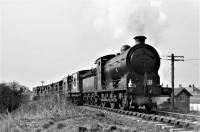
Knightswood Mineral Depot: On 27th March 1964 a brake van tour of goods branches around Glasgow was organised by the SLS. J37 64623 was in charge, and is seen on the Cowdenhill branch, crossing the bridge over Fulton Street, after visiting Knightswood mineral depot. This is a picture that causes me frustration in retrospect. Despite lovely weather, I took only three shots that day, only two were half-decent, and neither showed anything much of the interesting surroundings, concentrating as they did on the locomotive. When I think now that it was the only time I had an obvious chance to get a train on the Cowdenhill branch, not to mention the Hyndland-Crow Rd connection etc etc, the missed opportunities still rankle 56 years later!
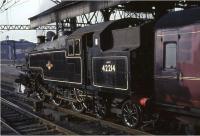
Glasgow Central: Fairburn 2-6-4T 42214 on station pilot duty at Glasgow Central in March 1964.
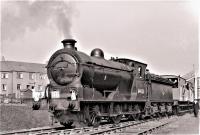
Hyndland: On 27th March 1964, a brake van tour of goods branches around Glasgow was organised by the SLS. J37 64623 was in charge, and is seen here moving off from the headshunt of Partickhill Goods Yard, adjacent to Hyndland station, on to the spur that connected with the ex-Caledonian line at Crow Road.
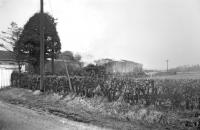
Gilnockie: The Langholm freight is temporarily halted alongside Gilnockie Station during Easter 1965. At this time a member of the train crew was responsible for opening and closing the level crossing gates, visible on the left.
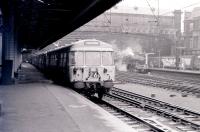
Glasgow Central: An EMU for Neilston leaves Glasgow Central on 27 March 1967. In the background 'Jubilee' no 45647 Sturdee awaits its departure time with the 10.05 to Leeds. See image [[21911]].
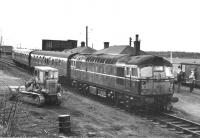
Smeaton: D5317 with Scottish Rambler No 6 at Smeaton on 27 March 1967. The special visited various locations in and around Edinburgh. See image [[29821]]
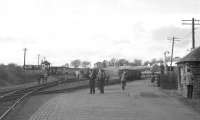
Haddington: Enthusiasts from the BLS/SLS Scottish Rambler No 6 Railtour at Haddington on 27 March 1967. The special, hauled by D5317, visited a number of locations in Edinburgh and the Lothians. See image [[29821]] [Ref query 8065]
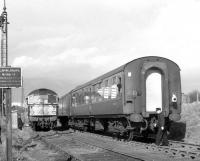
Haddington: D5317 running round Scottish Rambler No 6 at Haddington on 27 March 1967.

Glasgow Central: Jubilee 4-6-0 no 45647 Sturdee, a Carlisle Kingmoor locomotive, prepares to leave Glasgow Central and head for home on 27 March 1967, taking out the 1005 sevice to Leeds.

Haddington: D5317 with the BLS/SLS Scottish Rambler No 6 at Haddington on 27 March 1967.

Smeaton: BLS/SLS Scottish Rambler No 6 of 27 March 1967 stands at Smeaton behind D5317. See image [[4779]]

South Leith: Scene at South Leith on 27 March 1967 showing D5317 with Scottish Rambler No 6. The view is west, with a siding continuing beyond the level crossing over Constitution Street to serve warehouses along Tower Street. The large building opposite, on the corner of Constitution Street and Tower Street, is the North British Cold Storage & Ice Co Ltd. See image [[11374]] for the view from the factory site towards the station forty years later.

Penicuik [2nd]: Despite closure to passengers in 1951 Penicuik remained open for goods traffic for another sixteen years, due mainly to the surviving paper mills along the Esk valley. The branch eventually closed completely in 1967, as the final withdrawal notice bears witness.

Glasgow Central: Black 5 no 44796 relegated to humble station pilot duties at Glasgow Central in March 1967.
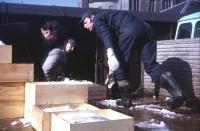
Fraserburgh: Loading fish for the London market at Fraserburgh on 27th March 1973. This and other insulated vans would leave on the (late morning) daily goods to Aberdeen where it would form part of the consist of the dedicated early afternoon fish train from Aberdeen to Kings Cross. See image [[45182]]
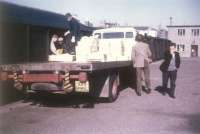
Fraserburgh: Aye, it can be a smelly old business... Fish boxes bound for London being loaded into vans at Fraserburgh 10 years to the day after Beeching - 27th March 1973. The stance of the gentleman on the right says it all. See image [[32177]]
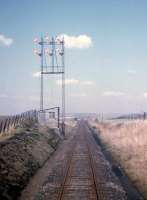
Elrick Signal Box: Double-take time! Elrick's signal test gantry seen from the brake van of the daily Fraserburgh-Aberdeen goods on 27th March 1973. This was located close to and south of the former Elrick signal box.
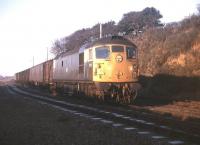
Maud: D5308 shunts Maud Junction on the daily Aberdeen-Fraserburgh goods on 27th March 1973. Note the parcels van - this traffic continued at Fraserburgh long after the withdrawal of passenger trains in 1965.

Maud: No Health & Safety Executive in those days! Fly-shunting at Maud Junction on 27 March 1973.

Lonmay: Mormond Hill (ye Mormond Braes) seen from the brake van of the daily Fraserburgh-Aberdeen goods on 27th March 1973.

Dyce: A fine array of semaphore signals glimpsed at Dyce station, looking back from the brake van of the daily Fraserburgh-Aberdeen goods on 27th March 1973.
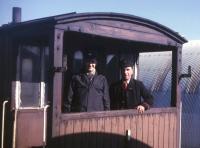
Fraserburgh: The guard and shunter of the daily goods from Aberdeen pose for the camera at Fraserburgh on 27th March 1973.
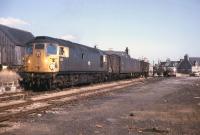
Maud: D5308 shunts seed potato wagons at Maud Junction en route to Fraserburgh on 27th March 1973.
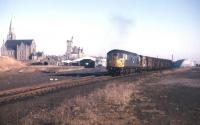
Fraserburgh: Class 26 no D5308 shunts the daily goods in Fraserburgh yard on 27th March 1973.
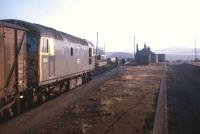
Maud: The morning sun illuminates 5308 shunting Maud Junction on 27 March 1973 prior to heading the daily goods from Aberdeen onwards to Fraserburgh.
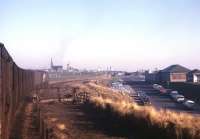
Fraserburgh: The daily goods from Aberdeen runs into Fraserburgh behind D5308 on a glorious March morning in 1973. The photographer and his chum David Fasken each paid the First Class equivalent fare for the luxury of travel in the brake van - money well spent!
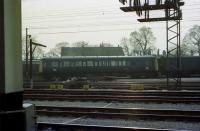
Preston: Single unit railcar in departmental service number TDB 975227, sits in the sidings at the south west side of Preston station on 27 March 1974.

Wigan North Western: Electric locomotives 86045 and 84006 on a Chrysler Linwood to Coventry container train through Wigan North Western on 27 March 1974.
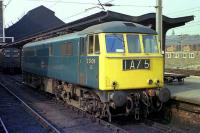
Preston: Class 86 E3108 sits in platform 4C at Preston on 27 March 1974. The loco has just been taken off a London to Carlisle service and replaced by a diesel prior to through electric haulage being introduced.

Wigan North Western: A London to Carlisle service pulls into Wigan North Western on 27 March 1974 behind class 86 E3108. Note the hairstyles and...no, never mind... see image [[15672]]
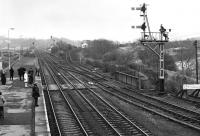
Haltwhistle: Looking east from the station footbridge at Haltwhistle on a grey 27 March 1976. The Alston branch curves away on the climb towards the viaduct over the South Tyne on the right, while a healthy complement of passengers waits on the staggered eastbound platform for the next service to Newcastle.

Alston: Class 101 power car No. E51437 is the centre of attention for a small band of enthusiasts who have just travelled on the early afternoon service from Haltwhistle on 27th March 1976.

Alston: There were only five weeks to go before closure when this class 101 3-car set, comprising vehicles E50146, E59530 and E51437, was photographed at Alston on Saturday 27th March 1976 ready to form the mid-day train to Haltwhistle.
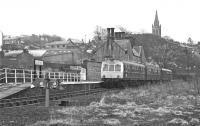
Alston: A DMU from Halwhistle stands at the Alston terminus on 27 March 1976. Two cars would normally have sufficed for the traffic to and from Alston but, so close to closure of the branch, the authorities were presumably expecting increased loadings due to enthusiasts paying their last respects.
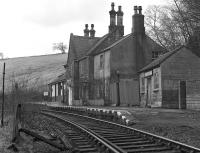
Lambley: Lambley station on the Alston branch in March 1976, displaying both a corporate image BR running-in board at the far end and a North Eastern Region painted board (doubtless with a tangerine background) above the door of the somewhat decrepit shed on the right.

Lambley: Lambley station and viaduct viewed from the south west in March 1976. Looking at the sylvan surroundings, it is difficult to imagine that there was once a coalfield immediately to the west of here, served by Lord Carlisle's Brampton Railway, which ran through from Brampton to Lambley.
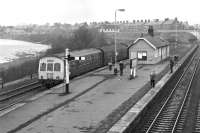
Haltwhistle: An afternoon Alston branch DMU, with class 101 power car No. E51437 leading, awaits a connecting service off the Carlisle - Newcastle line before setting out from Haltwhistle in March 1976.
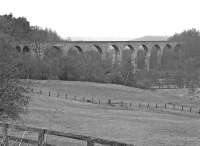
Lambley Viaduct: View of Lambley viaduct carrying the Alston branch across the South Tyne, photographed on Saturday 27th March 1976. Not exactly the brightest of days but at least the rain held off!

Newmarket: An easterly view under the extensive down platform canopy at Newmarket station on 27th March 1978. Built to shelter the large crowds that used to arrive at the station on race days, it had become redundant by the time this photo was taken and demolition was not far off. The 'bus shelters' seen on the opposite platform were already proving quite adequate for the remaining custom.

Ely: A Monday afternoon Kings Lynn to Liverpool Street service headed by 31 325 arrives at Ely's platform 2a on 27th March 1978.
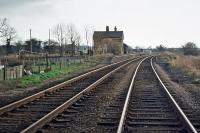
Fordham: The former Fordham junction station as it appeared on 27th March 1978, some 13 years after final closure to passengers. A peculiarity was that the station was once a shared intermediate calling point on two distinct lines, namely Chippenham/Snailwell Junction to Ely and Cambridge to Mildenhall. The line to Ely remained in use for through passenger and freight trains after the Mildenhall branch closed to passengers in 1962 and lives on, and although the station buildings survived for decades after the date of this photo, they eventually fell into dereliction and were engulfed by vegetation

Bescot Marshalling Yard: 25129 on an up trip from the curve at Bescot on 27 March 1981.
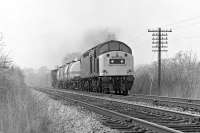
Wennington: 40169 east of Wennington station on 27 March 1982 with an eastound short train of chemical tanks. The tanks had no doubt originated at ICI Heysham and would probably be heading for Teesside.

Inverness MPD: Lineup of type 2s at Inverness depot on 27 March 1982.

Inverness MPD: Scene at Inverness shed on 27 March 1982, with 27102 partially in shot on the left, 27203 in the centre and an unidentified class 47 peeping out from behind the shed wall in the right background.

Wennington: Who would have thought in the early sixties, when the class was still in normal service on BR, that an ex-SDJR 2-8-0 would ever grace the metals of northern England? Preserved No. 13809 moves off from a stop at Wennington with the Carnforth to Hellifield leg of the 'Cumbrian Mountain Pullman' on March 27th 1982.
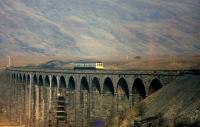
Ribblehead Viaduct: A southbound 2 car DMU crosses Ribblehead Viaduct on 27 March 1982. In the background above the DMU are the signals for Blea Moor SB.
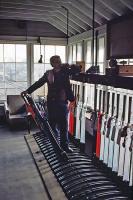
Colchester Town (St Botolphs): Activity inside St Botolphs signalbox, Colchester, on 27th March 1983. The signalman is on the phone making arrangements to turn an engineer's train via the Hythe triangular junction. This was a tricky task, involving reversals at Hythe and St. Botolphs in between the regular trains. The box was closed down in July that year.

Wakefield Kirkgate: 47823 is on the rear of the Royal train after reversing at Wakefield Kirkgate station in order to access the branch to Westgate on 27 March 1992. At the far end of the train 47835 leads the way.

Wakefield Kirkgate: 08525 running east through Wakefield Kirkgate station on 27 March 1992 with a long rake of bogie oil tanks.
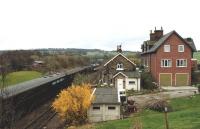
Crigglestone: The Royal Train being drawn out past the long closed Crigglestone West station by 47835 on 27 March 1992 after stabling overnight on the nearby former Horbury branch. The occasion was the visit by HM Queen Elizabeth to unveil a plaque to commemorate the 400th Anniversary of the Queen Elizabeth Grammar School in Wakefield. The train then reversed to run to Wakefield Kirkgate station, where it reversed again to access Wakefield Westgate station via the now single line branch linking the former L&YR route to the former GNR route.
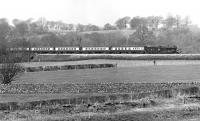
Melling Tunnel: Ex Somerset & Dorset 2-8-0 No. 13809 worked the northbound Cumbrian Mountain Pullman between Carnforth and Hellifield on the last Saturday of March 1982. It is seen here drifting into Wennington not long after leaving Melling Tunnel.

Lipiny: The afternoon sun glints off 2-6-2 No. Ol49-32 near Lipiny, Poland, on the 15.27 Wolsztyn - Nowa Sol train in March 1993. The angle of the photograph hides the fact that the train was composed of only two coaches - a featherweight load for such a powerful locomotive.

Konotop: Ol49-81 adds to the cloudscape as it departs from Konotop on the Wolsztyn to Nowa Sol line with the 12.33 departure from the former in March 1993. The water tower on the right is pure Prussian State Railways and betrays the fact that this was formerly part of Germany, only becoming Polish at the end of WW2.
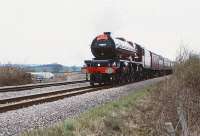
Oakle Street: LMS Princess Pacific 46203 Princess Margaret Rose, approaching the site of Oakle Street station on the GWR Gloucester to Newport line in March 1994 with a special.
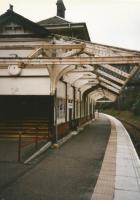
Maxwell Park: Maxwell Park station was not looking in terrific shape in March 1998. In fact the canopy glazing was soon to be replaced as part of an award-winning restoration and the station has looked dandy ever since

North Queensferry: 117 306 for Edinburgh calls at North Queensferry on 27 March 1999.
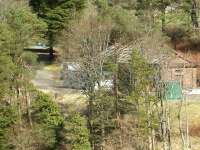
Victoria Lodge: Victoria Lodge terminus and yard from the top of Talla dam in March 2004 - the end of the platform can be seen in the gap between the trees in the left background.

Langho: 62005 on the Pendle Witch circular railtour on 27 March 2004, coasting downhill through Langho station before crossing the Whalley viaduct. The tour started at Carnforth and ran to Preston, Blackburn, Clitheroe and Helifield before returning to Carnforth via Wennington.

Southfield No 15 Signal Box: Substantial lineside hut on the Blackwood branch about a mile north of Blackwood heading towards Tillietudlem. This view looks to Blackwood. There were a number of rail served coalpits by the line here, all closed long before the line itself. 27 March 2005.

Merryton: View looking south over the site of the future Merryton station. Track is not down yet.

Merryton: Looking north towards Merryton station. Embankment preparation continues.

Larkhall Central: Looking north from Larkhall towards Merryton. The trackbed is ready for tracklaying.
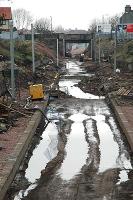
Larkhall Central: All quiet at Larkhall. The site is looking drier than usual.

Nethan Viaduct: Just north of the Nethan Viaduct is this huge retaining wall for a short branch to the long closed Fence colliery running west from a north facing junction.

Nethan Viaduct: Looking west at the piers of the former Nethan Viaduct looking very like John Thomas description of relics of an ancient civilisation.

Nethan Viaduct: Central ashlar pier of the Nethan Viaduct. This was one of the highest viaducts in Scotland.

Tillietudlem: Tillietudlem station looking north. A building survives on the southbound platform.

Tillietudlem: Inside the shelter at Tillietudlem station. View looks north. The two platforms can be seen to the left.
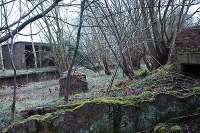
Tillietudlem: Looking south from the former building on the northbound platform of Tillietudlem station. The surviving building and platforms can be seen to the left and an old fireplace to the right.

Stranraer: Looking from the end of the headshunt from Stranraer Harbour platform 2 in March 2006 towards the Station. A run-round loop was still in situ there but the loop for platform 1 had been disconnected. The only pedestrian access to platform 2 at this stage was by picking a way round the end of the tracks, the footbridge having been removed. See image [[27142]]
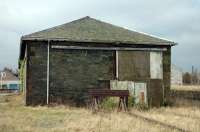
Stranraer Town: This was the main goods shed (and later tamper shed) at Stranraer Town, looking towards the station in 2006 See image [[59353]].

Stranraer: View back towards the town from Platform 2 at Stranraer Harbour on 27 March 2006. The signal box was switched in on this occasion.
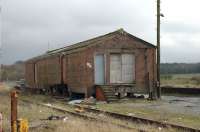
Stranraer Town: One of the goods sheds at Stranraer. Views look east from Town terminus.
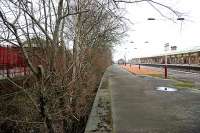
Kilmarnock: The abandoned and overgrown through platform on the north side of Kilmarnock station. 2006.
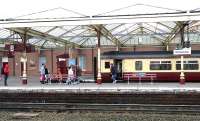
Kilmarnock: Arrival from Stranraer Harbour at Kilmarnock on 27 March 2006.
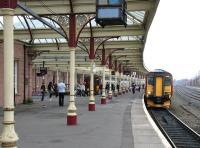
Kilmarnock: A Glasgow - Carlisle service arrives at Kilmarnock platform 3 on 27 March 2006. Recently arrived in bay platform 2 is the 11.48 from Stranraer Harbour, which will depart as the 1350 to Glasgow Central.
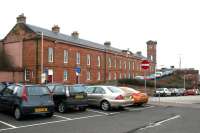
Kilmarnock: The classic lines of Kilmarnock station looking south in March 2006.

Kilmarnock: North facing bay platforms 1 and 2 at Kilmarnock. March 2006.

Stranraer Town: Looking east from Stranraer Town Station, taken in March 2006, not long before the site was cleared.
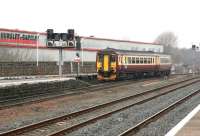
Kilmarnock: Passing a famous name. The 11.48 from Stranraer Harbour comes off the Troon line and into the platform 2 bay at Kilmarnock in March 2006. This train continues as the 13.50 Kilmarnock - Glasgow Central.
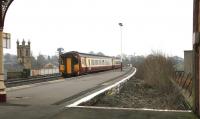
Kilmarnock: A train leaving Kilmarnock for Carlisle in March 2006, photographed looking over the abandoned bay platform at the south end of the station, with the old West Kirk standing on Portland Street in the left background.
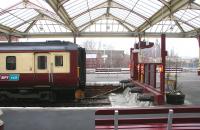
Kilmarnock: A train for Glasgow Central waits in the bay at Kilmarnock station on 27 March 2006.
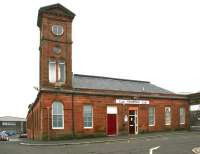
Kilmarnock: The main building and tower at Kilmarnock in March 2006. The platforms can just be seen to the right.

Stranraer: Harbour station looking from buffer stops in March 2006 see image [[23416]]
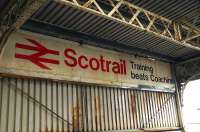
Stranraer: A rather dated advertisement in Stranraer Harbour Station on 27 March 2006.
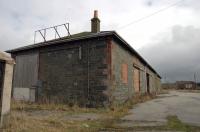
Stranraer Town: The main goods shed at Stranraer. Views look east from Town terminus. For a while this was the tamper shed.

Stranraer: Entrance to Stranraer Harbour station from the quayside on 27 March 2006.
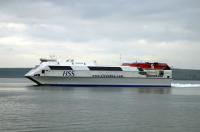
Stranraer Harbour: Stena Line fast ferry 'Stena Voyager' passing Cairnryan inbound from Belfast for Stranraer, on 27th March 2006. These vessels were very expensive to operate and I understand 'Voyager' has since been scrapped.

Springfield: Tractor driver operating the lever controlling the barriers at Hospital Mill level crossing near Springfield.

Bridgeton [2nd]: Platform Side of Station Building. The once bustling Archways blocked up. Looks like some maintaince may be needed.

Bridgeton Central Tunnel: Entering the first tunnel from Bridgeton Central heading for Gallowgate Central... The trackbed has been cleared so well... what next?? Rails.

Bridgeton [2nd]: Bridgeton Central station throat... the build up of rubbish notably tyres has been cleared ... work is obviously still in progress (Anyone know what is happening?). This continues to Gallowgate Central Junction.

Bridgeton [2nd]: Through the brick you can just make out a support pillar albeit looking slightly loose.

Bridgeton [2nd]: Sign warning of the overhead cables still in place on the facade of the building.

Bridgeton [2nd]: The throat of Bridgeton Central station, the box was to the right just through the gate. Pic was taken from the car park of the now Arran day centre.

Dalgety Bay: Commemorative plaque on display at Dalgety Bay station on 27 March 2008. Over the ten years since the station opened the car park has been increased in size, platforms lengthened, CCTV put in, ticket issuing machines installed, waiting areas improved.... not bad for a station BR didnt seem to want!

Dalgety Bay: Happy birthday to you! First ScotRail 170 455 leaves Dalgety Bay on 27 March 2008, the occasion of the stations 10th anniversary.

Springfield: 1352 Aberdeen to London 125 south of Springfield.

Kincardine: The rebuilt level crossing at Kincardine looking east towards the old station house and village on 27 March 2008. The crossing once gave access to Kincardine power station.

Springfield: Late afternoon at Hospital Mill Crossing near Springfield on 27 March 2008. Crossing cottage stands on the left.

Kincardine Junction: View west along the trackbed of the S&D towards the site of Kincardine Junction on 27 March 2008, showing the newly installed signal standing at the east end of Alloa loop. Mr Rabbit appears less than impressed that someone has left the light on.

Dalgety Bay: A northbound 158 pauses at Dalgety Bay on 27 March.

Drysdale Street Tunnel: Part of the information board standing on the old wagonway route alongside the Station Hotel outlining the story of the Alloa Wagonway. March 2008.

Drysdale Street Tunnel: Looking north towards the Alloa ring road on 27 March with the Station Hotel standing on the right. This is the trackbed of the former Alloa Wagonway, dating from the 1760s, a small memento of which can be seen on the left. A short history is also privided nearby - see [[18967]].

Drysdale Street Tunnel: The Station Hotel, Primrose Street, Alloa, built opposite the original Alloa railway station and seen here on 27 March 2008. The design of this strangely wedge-shaped building was determined by the route of the former Alloa Wagonway, via which loaded coal wagons came in from the left along the line of the current ring road (albeit pre-dating it by 200 years) and then swung south along what is now the walkway to the right of the Hotel, heading towards the Forth. An information point commemorating the Alloa Wagonway stands below the signpost on the right of the picture.
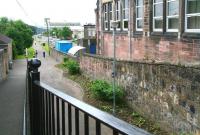
Bedford Place Tunnel: Scene in Alloa town centre on 27 March 2008 looking south towards the Forth. Down below is the trackbed of the Alloa Wagonway which has just emerged from under Bedford Place. Today much of the old route is a walkway running north-south through the town, the southern extent of which now ends in the middle distance. Dominating the background are the buildings of Alloa Glass Works. Visible near the end of the path (standing on the grass verge alongside) is one of two identical information points along the route, the other being at the north end by the Station Hotel - see [[18968]].

Drysdale Street Tunnel: Standing inside the Drysdale Street/Mar Street tunnel on 27 March 2008 looking north, back towards the Station Hotel and the ring road. According to the information point alongside the hotel the route remained in use until 1924.

Drysdale Street Tunnel: View along the former Alloa Wagonway on 27 March 2008 showing the route heading south from the Station Hotel towards the overbridge at the junction of Drysdale Street and Mar Street. Note the steel buttressing added during the last century and the steps that now provide pedestrian access to street level. In the background maintenance work is taking place.

Drysdale Street Tunnel: Route of the Alloa Waggonway looking south from above the Drysdale Street/Mar Street tunnel on 27 March towards the Forth. Work on the retaining walls was taking place on this part of the old alignment at the time. In the distance is the tunnel under Bedford Street.
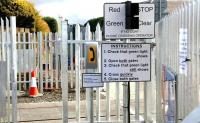
Kincardine: The new user worked level crossing at Station Road, Kincardine, following testing on 27 March 2008. The crossing had been installed in advance of reopening of the line east from Alloa for use by the heavy coal trains then running between Hunterston Import Terminal and Longannet Power Station via the Forth Bridge. The first of the rerouted trains, travelling via Stirling and Alloa, passed through here 9 days later.
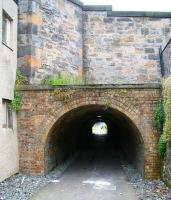
Bedford Place Tunnel: The tunnel under Bedford Place, Alloa, on the route used by the Alloa Waggonway on its journey to the Forth. Photographed looking south in March 2008 along what is now part of a walkway through the centre of the town.
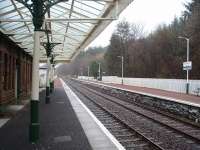
Dalmally: With only three services in each direction on the Oban line you have to choose carefully where you will photograph the train in a station. On this day I opted to see the train at Connel Ferry but still called at Dalmally for this view east towards Crianlarich.

Dalmally: View west towards Loch Awe, from under the shelter of the platform canopy, at a very wet Dalmally station. Dalmally is one of two stations between Crianlarich and Oban that retain its passing loops, under radio signalling control.
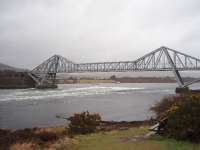
Connel Ferry Bridge: Under the Connel Ferry bridge the Falls of Lora, a phenomenon caused by an underwater ridge, can be clearly seen with the ebb tide, as shown here from the south shore. This also acts in reverse as the flood tide enters Loch Etive and a spring tide such as this one makes the free show even more spectacular. The old railway bridge of course is worth seeing at any state of the tide.

Connel Ferry: Oban bound Sprinter 156467 leaves the last stop at Connel Ferry passing, on the left, the tree covered mound that was once an island platform. This gave the former junction for Ballachulish three platforms, now reduced to just one.

Thurso: The forlorn-looking livestock auction shed alongside Thurso station on 27 March 2009.

Thurso: View out along the platform at Thurso station on 27 March 2009.

Scrabster Harbour: The morning ferry backs off from the floating gangway at Scrabster before heading north to Stromness. The ferry terminal is approximately 2 miles from Thurso station.

Connel Ferry: The first train of the day for Oban, formed by Corkerhill Sprinter 156467, pulls in to a deserted Connel Ferry station, where the track has recently been tamped and there is also some spot resleepering. A Civil Engineers' machine was parked in the siding just beyond the platform.
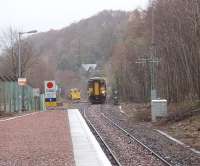
Connel Ferry: The eastern approach to Connel Ferry, formerly a three platform junction station but now just a plain single line with a short siding. The sidings in the oil depot alongside the platform are now lifted. The remaining siding is seen here occupied by a civil engineering machine that had probably been used in connection with the resleepering that could be seen in the station area. 156467 approaches heading for Oban.
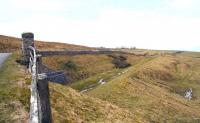
Stainmore Summit: After topping Stainmore Summit, westbound trains on the South Durham and Lancashire Union Railway commenced a 3 mile descent towards Barras. This view from a bridge on an unclassified road approximately a mile on from the summit looks south west in the general direction of Barras in March 2010, nearly half a century after closure.

Renton: Lord Elgin inside the King Robert the Bruce Heritage Centre created by Strathleven Artizans in the former booking office at Renton Station.

Renton: Lord Elgin opening the King Robert the Bruce Heritage Centre created by Strathleven Artizans in the former booking office at Renton Station.
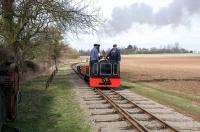
Statfold Barn: Former Penrhyn Quarry narrow gauge 0-4-0ST Edward Sholto (Hunslet 996 of 1909) photographed on 27 March 2010 during an open day on the Statfold Barn Railway.
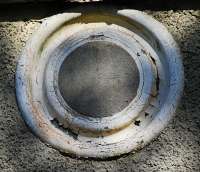
Crossroads: This roundel is on the track side of the former station building at Crossroads in Dundee. Was this a station clock? The station was located to the north of the Law, its inclines and tunnel. Remarkably this station and the terminus at Newtyle still stand - perhaps the oldest station buildings in Scotland.
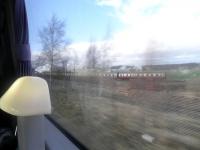
Manuel High Level: 246 Morayshire with an SRPS train arriving at Manuel on 27 March, as seen from the passing 1530 Glasgow Queen Street - Edinburgh Waverley service.

Fylde Junction: Pendolino for Blackpool? Well not yet although electrification is planned. 390041 is seen on layover on an electrified siding outside Preston Power Box because the WCML line north of Preston was closed for weekend engineering. Northern 158909, in promotional livery, slows for the red signal as it approaches the junction on a Blackpool to York service.

Airdrie: Balloch bound 320319 awaits departure from bay platform 1 at Airdrie on 27 March 2010.

Statfold Barn: 0-4-2T Saccharine (Fowler 13355 of 1914), originally built for a South African sugar plantation, seen here operating on the Statfold Barn Railway on 27 March.
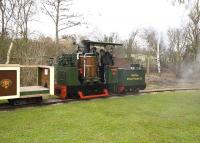
Statfold Barn: 0-4-0VBT Paddy in action on the Statfold Barn Railway on 27 March. The vertical boilered locomotive is sporting a new roof... which guaranteed a dry and pleasant day.

Stainmore Summit: The trackbed of the SDLU line to the east of Barras looking towards Stainmore Summit on 27 March 2010. Note it is not raining... yet
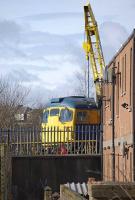
Methil: Privately preserved 26040 peeps out from a corner of Methil goods yard where it is stored along with a diesel crane, BR 20t brake van and some buses. Photographed on 27 March 2010.

Dundee West Goods: Dundee holding sidings looking west on the 27th of March, 2010. Dundee (Tay Bridge) station is located in a cutting to the left and Dundee West was located to the right.
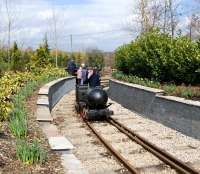
Statfold Barn: Sid is a 2ft gauge compressed air locomotive, seen here in action on the Statfold Barn Railway on Saturday 27 March 2010. (To reverse, stop - then push in the opposite direction!)
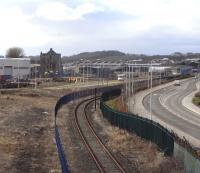
Rosyth Dockyard: Is this Scotland's least-used working branch? Looking west along the Rosyth Dockyard line towards the docks on 27 March 2010. In the background is the Babcock Engineering's shed see image [[22278]] and on the left is Rosyth Castle. It's hard to believe but until the Royal Dockyard was built round it in Edwardian times this was on a tidal island off a shore with no signs of habitation: the settlement of Rosyth simply didn't exist until built from scratch as a 'garden city'.
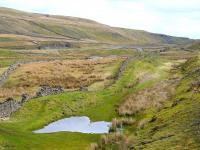
Stainmore Summit: Scene in the High Pennines, to the east of Barras, on 27 March 2010. View is east along the trackbed of the South Durham and Lancashire Union Railway towards Stainmore Summit. The A66 trunk road crosses the picture in the background.
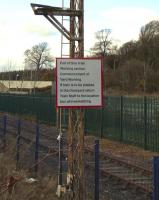
Rosyth Dockyard: A notice to the driver on an armless signal post on the approach to Rosyth Dockyard, photographed on 27 March. Don't confuse 'Train Staff' with Train Crew, as I first did, or it becomes a little absurd.
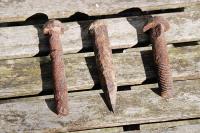
Law Incline: Three vintage bolts found by a householder in a garden to the east side of the former Law Incline (between Dundee Ward Road and the Law Tunnel). Suspected to be screw spikes or track fasteners. They're in not bad shape given line closure in the 1860s. Does anyone know their exact purposes? [Thank you very much for the replies so far. For completeness here are extracts from three replies; 'The left hand one is a chair spike, which was used with a wooden treenail to secure early chairs to wooden sleepers. The right hand one is a bullhead fishbolt. Not too sure about the middle one, some kind of spike or fang bolt?' and from another reply 'the centre fixing could well be a spike for fastening down track' and a further comment 'if the centre spike has an offset head then it is most likely for fixing an early cast flat bottom rail to a wooden sleeper'.]

Stainmore Summit: Looks like rain. The descent from Stainmore summit on the former South Durham and Lancashire Union Railway on 27 March 2010. View is west along the trackbed towards Barras and Kirkby Stephen. The trans-Pennine route closed in early 1962 and the final commemorative special ran on 20 January that year (see image [[24103]]).
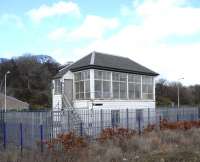
Rosyth Dockyard: The signal box at Rosyth Dockyard in March 2010. Everything inside appears to be present and correct, but understandably there's a lack of personal touches.
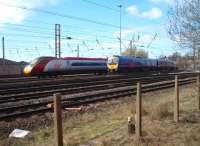
Fylde Junction: Pendolino 390012 is stabled on an electrified siding outside Preston power box (built on the site of Preston steam shed) in between London trips. The line to Lancaster (going off to the right) was closed for weekend engineering so Virgin services turned back here. TPE 185142 leaves the Blackpool line to run into Preston station on its way to Manchester Airport. The ramshackle looking fence posts in the foreground have been replaced by a substantial fence a few feet further away from the line.

Fylde Junction: The Help for Heroes special excursion drops into Preston on its way from Lancaster to York. LMS 8F 48151, standing in for 46115 Scots Guardsman, leads 70013, running as 70048 The Territorial Army 1908-2008, and a lengthy train of coaches.
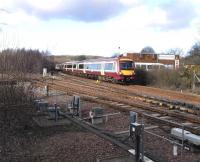
Inverkeithing Central Junction: Behind the points paraphernalia at this busy junction the tracks seem almost incidental. To the left is the line to Dunfermline and the western half of the Fife Circle; the incoming Outer Circle service, formed by 170 474 in SPT livery (by no means unusual in Fife) would have passed that way over an hour previously. In the distance a Dundee semi-fast accelerates away from its Inverkeithing stop on the climb to Dalgety summit. March 2010.

Leyland: The Help for Heroes special from Lancaster to York is seen passing Farington just north of Leyland on 27 March 2010. 48151 is leading as substitute for Scots Guardsman which is still poorly after the problems of 13 February. Train engine is 70013 Oliver Cromwell running as 70048 The Territorial Army 1908-2008 but of course when 70048 was around it was the 50th anniversary that the loco commemorated in 1958!

Milton of Crathes: Andrew Barclay saddle tank No. 807, 'Bon Accord' being shunted to her new purpose built shed on the Royal Deeside Railway at Milton of Crathes on 27 March 2010. The inclement weather earlier in the year had delayed her arrival on two occasions, but this time it was 'third time lucky' and a good crowd was present to welcome her to her new home. See image [[18043]]
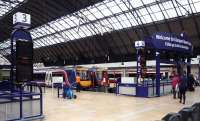
Glasgow Queen Street High Level: View over the ticket barriers towards the platforms at Glasgow Queen Street on 27 March 2010.

Airdrie: The 1608 Drumgelloch - Balloch service approaching Airdrie's platform 2 on 27 March 2010 with work underway in connection with the rebuilding of the eastbound through platform for use by future Bathgate/Edinburgh trains.
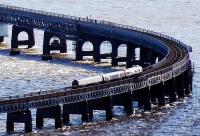
Tay Bridge: A southbound service heads round the curve at the north end of the Tay Bridge.
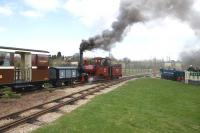
Statfold Barn: Sragi No. 14 from Sragi sugar mill, Central Java, in action at an open day on the private Statfold Barn Railway near Tamworth on 27 March 2010.
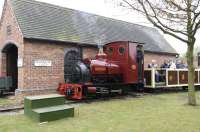
Statfold Barn: Hunslet 0-4-0ST Statfold, a new build in 2005, seen here on 27 March 2011 with a train on the Statfold Barn Railway.

Shawlands: On the approach to Shawlands from the north the Cathcart Circle first crosses Shawmoss Road (seen here) and then the Barrhead line (off to the left). This view looks west.

Crossmyloof: This is a photograph of both the Barrhead line and the Cathcart Circle. Choosing a location name for this was tricky! 156 514 is northbound underneath the northern approach to Shawlands station (which is off to the left) and viewed from the neighbouring footbridge.

Maxwell Park: Across Springkell Avenue from Maxwell Park passenger station was the goods station. This was on the east (or south) side of the line (the inner circle side) and was located to the left in this view which looks along the line to Cathcart. It was a fair size of yard having six sidings and a loop off the line and headshunt. The little trackside building in the background right looks suspect ... a railway staff house?
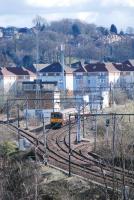
Cathcart North Junction: 314205 takes the Cathcart route at Cathcart North Junction. Both the line on the left and the one to the right ultimately head left (east) for Newton. The single line on the right burrows under the Cathcart Circle. The tall building to the left of the train is Cathcart Signalbox. The train is just approaching what was the original terminus of the line, just shy of the river. View looks south.
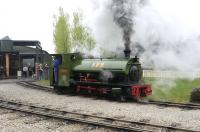
Statfold Barn: SBR 0-6-0ST No 1 (Peckett 2050 of 1944) seen in operation on the Statfold Barn Railway on 27 March 2011. The locomotive is a former resident of Harrogate Gas Works.
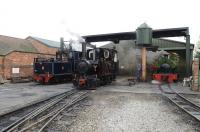
Statfold Barn: Narrow gauge locomotives at the privately owned Statfold Barn Railway in Staffordshire on 27 March 2011.

Langside: The entrance to Langside (and Newlands) station from Langside Drive. The view looks south with the station off to the left.
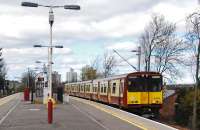
Langside: A Newton service (314 201) pauses at Langside station in March 2011. The 1970s 'lego brick' style station building has been replaced by a glass tank. The on-platform fencing, an attempt at 'revenue protection', has also gone. The original station building burned down on the 13th of August 1966 but struggled on for a while.
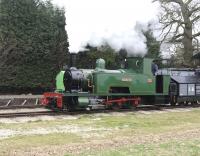
Statfold Barn: Isibutu, a former South African sugar company Bagnall 4-4-0T of 1945, seen in action on 27 March 2011 on the Statfold Barn Railway.

Cathcart West Junction: This view looks east to Cathcart station and shows the trackbed and missing bridge of the former Lanarkshire and Ayrshire 'Cathcart bypass' (forgive my description). It is surprising that during the works to slew the track onto their new alignment and junction that some method of building platforms on the route to Newton was not found.
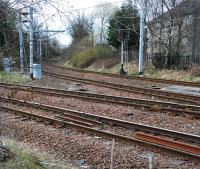
Cathcart West Junction: To the left is the line to Neilston and running away to the distance in the centre is the route to Langside. The photograph is taken through a fence at a location which was the trackbed of the Lanarkshire and Ayrshire Railway - this formerly passed Cathcart without being able to take trains from the Langside direction on to Newton as there was only a Neilston to Cathcart spur onto the Cathcart Circle west of the station (the two tracks in the foreground here). Langside to Newton trains were permitted by a new connection from Cathcart West Junction onto the Lanarkshire and Ayrshire and at the same time the 'bypass line' was lifted. See image [[8865]] for a view of the former layout.

Pollokshields East: A northbound sprinter passes the Muirhouse Central Junctions on the Glasgow Central approach lines of 1879. This is the view from the steps up to Albert Drive.

Statfold Barn: Built as recently as 2005, Hunslet 0-4-0ST Statfold, photographed with a train on the Statfold Barn Railway, Staffordshire, on 27 March 2011.
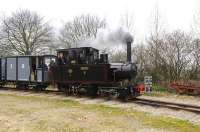
Statfold Barn: Pakis Baru No 5, an O&K 0-4-4-0T Mallet of 1905, ex- Indonesian sugar mill, seen on 27 March with a train on the Statfold Barn Railway.

Pollokshields West: An outer Circle train pauses at Pollokshields West. The modern shelter is hardly comparable with the old building, but at least gives some protection from the elements. It seems incongruous that the street level building at Strathbungo, closed since 1962 and seen in the distance, remains standing but then it was easier to give that over to other uses (currently 'Susies Store', no ').
It always feels to me like the station names should be Pollokshields North and South but a quick look at an OS map confirms the 'horizontal' distance is greater than the 'vertical' distance between Pollokshields East and West.

Shawlands: Jack Kernahan, in 'The Cathcart Circle' describes what's seen here thus
'The passengers on the trains were likely on this section to miss one of the principal features of the new line, namely the two four-apartment houses, provided for the station masters, which were built in the five arches of the viaduct carrying the line between the girder bridges at Rossendale and Pollokshaws Roads, the only evidence of the houses to the passengers being the chimneys growing from the parapets.'
The entrances are seen here in March 2011. These are on the east side of the line - Rossendale Road is off to the left and Pollokshaws road is immediately behind the camera. Both houses were in use as offices until recently.
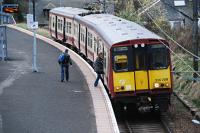
Shawlands: An outer circle train pauses at Shawlands station's curved platform face. The station is a little bare now without the station building. Between 1905 and 1907, only a few years after the line was extended to form a circle, a number of stations on the circle were provided with extra entrances - this photograph is taken from one of these, a footbridge at the north end of the station.

Muirhouse North Junction: An outer circle service takes the Cathcart Circle at Muirhouse North Junction and prepares to stop at Pollokshields East. The two used tracks to the left are the route to Barrhead and Kilmarnock and the disused single track further left is the remains of the C.E. Yard (formerly carriage sidings and once a timber yard). March 2011.

Muirhouse Central Junction: Two piers which supported the signal gantry at Muirhouse Central Junction still stand. Here the Cathcart Circle (two closest lines) leave the route to Barrhead. The view looks east in March of 2011.
Sitting comfortably? Here goes.
The first line on the ground here was the General Terminus line of 1849 (in particular the Terminus Junction to Strathbungo Junction curve). This was followed 30 years later by the approach to the new Glasgow Central terminus (this met the General Terminus line beside the distant pier seen here). Finally in 1894 the Cathcart branch was extended from Cathcart west through Maxwell Park to Muirhouse Central Junction to form a 'circle'. At the same time a short connection was made between Muirhouse Central Junction and Muirhouse North Junction (old) to allow access to Glasgow Central. As a result there was a short section of quadruple track between the old Muirhouse North and old Muirhouse South junctions, a feature arising from the order of openings, but this no longer exists. The lifted section was running off to the left here, in line with the further away pier. The junction names have been re-used for what were Cathcart Junction (later renamed Pollokshields East Junction on opening of the Lanarkshire and Ayrshire Railway to save confusion) and Strathbungo Junction respectively.

Pollokshaws East: An outer circle service train draws to a halt at Pollokshaws East. The view is from Kilmarnock Road and looks west. See image [[7360]] for the same view 24 years earlier.

Maxwell Park: A short distance to the Cathcart side of Maxwell Park (and former goods yard) the Cathcart Circle line turns south to cross the B768 (Titwood Road) on a long and low girder. This March 2011 view looks west at the bridge.

Pollokshaws East: The entrance to Pollokshaws East on Kilmarnock Road is quite a grand affair, even with the lamp missing from the lampholder. Two castellated sets of steps climb to the entry stairway.
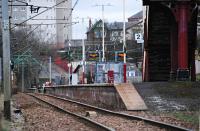
Shawlands: Shawlands station viewed from the bridge over the Barrhead line. The line here looks a little bumpy, but then this is pretty telephoto. I'd never noticed before that many Cathcart Circle stations are built like island platforms on single track railways - one face being straight and the other curved. Then again it is a circle with most stations on curves so I should have thought that through. See image [[7511]] for the same view, but considerably less telephoto, 24 years earlier. Building now gone, trains changed.
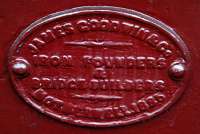
Pollokshields East: Builder's plate for the span of the Albert Drive bridge which crosses the Cathcart Circle. The plate reads
IRON FOUNDERS
&
BRIDGE BUILDERS
MOTHERWELL.1886
which suggests this is the original bridge over the line. Goodwin must have been busy as they were also undertaking the Jubilee Bridge over the Hooghly River in India about the same time.
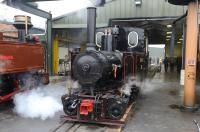
Statfold Barn: Former Indonesian sugar mill, 0-4-4-0T Mallet 'Pakis Baru No 5', stands alongside the servicing facilities on the Statfold Barn Railway on 27 March 2011.

Maxwell Park: 314 208 takes an inner circle service south amongst the tenements of Maxwell Park drawing to a halt at the station of the same name. The park itself is off to the right over Terregles Avenue.
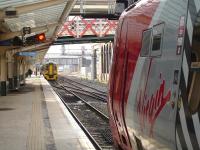
Chester: 158818 stands at the west end of platform 3 at Chester on 27 March during reversal of the 13.08 ex Birmingham International to Llandudno & Holyhead service. The Virgin Voyager in the foreground will lay over for another 70 minutes before forming the 16.35 departure to London Euston.
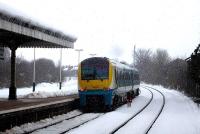
Wrexham General: The 09.21 Cardiff - Holyhead service, formed by unit 175003, leaves a snow covered Wrexham General during a snowfall just after mid-day on 27 March 2013.
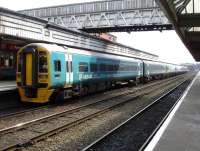
Shrewsbury: Arriva Trains Wales 158818 at Shrewsbury on the rear of the 6-car 11.33 service on to Birmingham International. The train reverses here following arrival off the Cambrian Coast line.

Ruabon: A near 150mm layer of snow has almost engulfed Ruabon Station. View north towards Wrexham from the station footbridge on 27 March 2013.
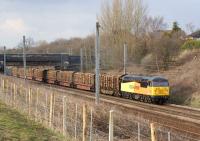
Farington Curve Junction: A resplendent Colas Rail Freight Class 56 southbound near Farington Curve Junction on 27 March 2013. No 56106 is hauling 15 loaded timber wagons from Carlisle to the Kronospan factory at Chirk.
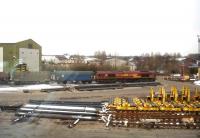
Wolverhampton Steel Terminal: A grab shot of the Wolverhampton Steel Terminal in 2013.
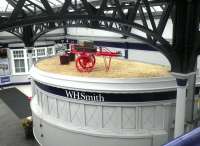
Stirling: This Victorian railway barrow presented by the Stirling Smith Museum and Art Gallery to Stirling Rotary has now been restored by them and placed on display at Stirling Station.
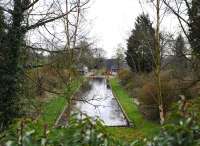
Savernake High Level: View over Savernake High Level Station, Wiltshire, closed in 1958, formerly part of the Midland & South West Junction Railway. [Ref Query 6253]
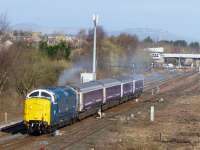
Edinburgh Road Bridge Junction: Running in the guise of former Finsbury Park classmate 55003 'Meld', 55022 sets off from Perth with an Inverness - Polmadie ECS working on 27th March 2015.
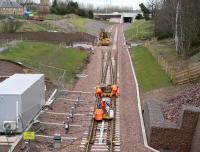
King's Gate Junction: Track work in progress in the area around Kings Gate points on the Borders Railway just south of the Edinburgh City Bypass on 27 March 2015.
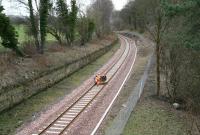
Sheriffhall [2nd]: Another walker heading south towards Eskbank, 27 March 2015 see image [[38706]].
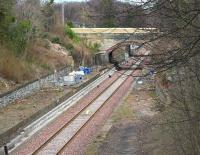
Eskbank and Dalkeith: View north through the old Eskbank station on 27 March 2015.
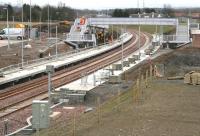
Shawfair: Work continuing at the new Shawfair station on 27 March 2015 with the footbridge the centre of activity on this occasion. View south towards Sheriffhall.
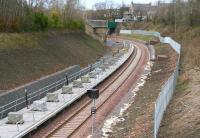
Gorebridge: Scene at Gorebridge on 27 March 2015, looking north along the platform towards the station building.
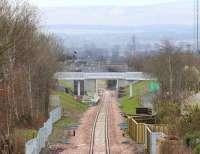
Eskbank: The line south through Eskank (new) on 27 March 2015. The whole area has been tidied up considerably since the last visit. Just beyond the station the line swings left onto the bridge over Hardengreen roundabout. See image [[49218]]
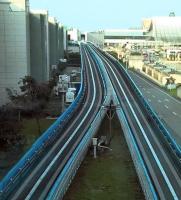
Taipei Airport: This view from Terminal 2 to Terminal 1 of Taipei Airport in Taiwan shows a compact public transport system known as Skytrain. A train is just visible in the T1 station. One track is for airline passengers only; the other, separated by barriers at each platform, is for general public use. There aren't any rails - shall we call this a guided trainway? see image [[35697]]
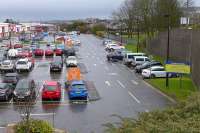
Dunfermline Upper: Looking east from Inglis Street over the site of Dunfermline Upper station, now a retail park. Only the concrete retaining wall remains. 27 March. See image [[50641]] for the same view in 1973.
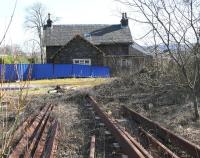
Beattock: The boarded up former station master's house at Beattock in March 2017. View is east with the WCML passing directly behind the camera. The station buildings themselves are long gone see image [[37674]]. [Ref query 988].
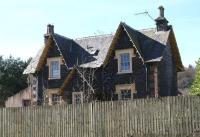
Beattock: Front view of the fenced off (and slightly creepy looking) former station master's house at Beattock. Photographed looking west in April 2016, with the WCML running past just beyond. see image [[58672]].
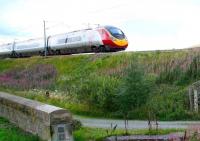
Wandel Mill Signal Box: A Waverley bound Pendolino speeds past Wandel Mill on 27 March 2017. The train will leave the West Coast Main Line approximately 10 miles north of here and take the Edinburgh route at Carstairs South Junction.
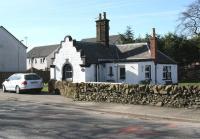
Beattock: 'At the end of the station approach road the single storey former gate lodge also still stands, again probably by Tite...' (Britain's Historic Railway Buildings - Gordon Biddle). Looking south west across the main road through the village on 27 March 2017, just beyond the building the Beattock station approach road runs off to the right.
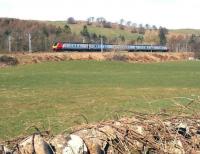
Beattock: A Voyager heads south shortly after passing through the remains of Beattock station on 27 March 2017. See image [[58903]]
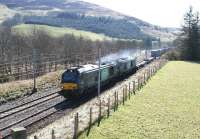
Lamington: Approaching out of the sun on 27 March after crossing the Clyde at Lamington is the 0616 Daventry - Mossend Tesco containers. DRS 68002 Intrepid and 68023 Achilles accelerate the lengthy train north away from the viaduct.
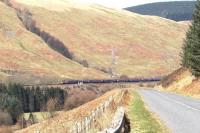
Greskine Signal Box: A Virgin Pendolino on an early afternoon Glasgow Central - London Euston service descending Beattock Bank in March 2017.

Greskine Signal Box: The 0729 Manchester Airport - Edinburgh Waverley climbing Beattock bank north of Greskine on 27 March 2017.
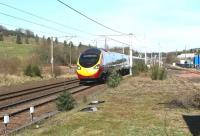
Beattock: A Euston bound Virgin Pendolino speeds south through the site of Beattock station on 27 March 2017. View is north over the remains of the up platform with the old Moffat bay on the right.
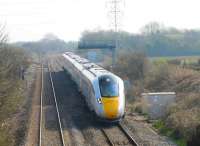
Stormy Loops: 5X20 North Pole Iep Depot to Swansea Mailphant Csd passing Stormy Loops for another week of Staff training.
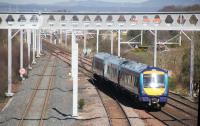
Greenhill Lower Junction: It is still possible (just) to get a shot from the road bridge at Greenhill lower. Caught through the new forest of metal and wires is 170 407. This view is looking east towards Carmuirs. Work is still on going on the electrical supply station sub station in the Y between high and low lines.
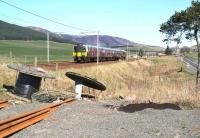
Wandel Mill Signal Box: The 1109 First TransPennine Glasgow Central - Manchester Airport runs parallel with the A702 between Lamington and Abington past a Network Rail access point on 27 March 2017.
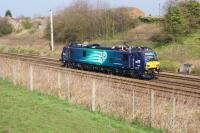
Farington Curve Junction: Out on the mainline using electric traction, a new DRS Class 88 is seen approaching Farington Curve Jct whilst working light engine from Crewe to Carlisle. This was the return working on 27 March 2017 with 88002 'Prometheus' having the honour of making the run.
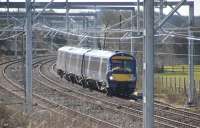
Greenhill Lower Junction: It is still possible (just) to get a shot from Greenhill lower. Caught through the new forest of metal and wires is 170 455 in this view looking west towards the upper junction.
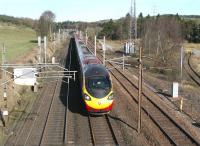
Beattock: Having completed the descent of Beattock bank, the 0840 Glasgow Central - London Euston is about to run through the site of Beattock station, located just behind the camera, on 27 March 2017.
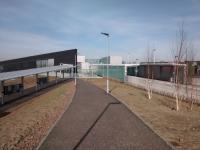
Edinburgh Gateway: The street approach to seen on 27/03/2017. The tram stop is on the left with the station on the right. A distinct lack of people around, as is my experience of this place so far. Give it time, though ...

Beattock: DRS 37259 leaves a smokescreen over the down loop at Beattock on 27 March 2017 as it restarts its journey north, following an interruption to permit the passage of a Glasgow bound Pendolino.
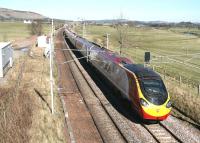
Lamington: The 1140 Glasgow Central - London Euston Virgin Pendolino glides south through the site of Lamington station on 27 March 2017. Nothing remains of the station itself, which closed to passengers at the end of 1964, although the location is now used as an access point by Network Rail. See image [[6561]]

Stranraer: Stena no more. The quayside alongside Stranraer station.
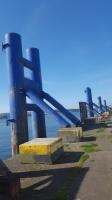
Stranraer: Despite appearances, Stranraer pier is not equipped with bouncy castles.
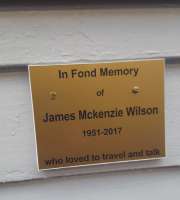
Stranraer: Stranraer plaque - unveiled today in memory of the SAYLSA company secretary James McKenzie Wilson who died last month.
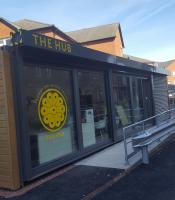
Ayr: 'Active Travel Hub' at Ayr. This converted shipping container run by the Ayrshire Roads Alliance is just outside Ayr Station.
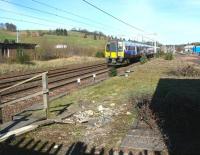
Beattock: The remains of Beattock station looking north through the Network Rail access gate on 27 March 2017. The approaching train is the 0906 First TransPennine Express Glasgow Central - Manchester Airport.
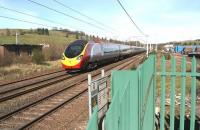
Beattock: View north from the site of the up platform at Beattock in March 2017. Beyond the green fence is Beattock relay room and a Network Rail access point. (Timber loaded over on the right beyond the old Moffat bay is in the yard of a road transport company.) The passing train is the 0730 London Euston - Glasgow Central.
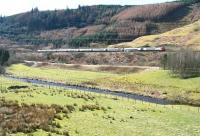
Greskine Signal Box: Running parallel with the Elvan Water on the climb to Beattock summit near Greskine on 27 March 2017. The Pendolino is the Virgin Trains 0643 London Euston – Birmingham New Street – Edinburgh Waverley.
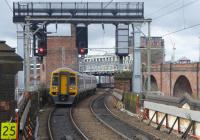
Castlefield Junction: 158754, on a Manchester Oxford Road to Selby service, passes Castlefield Junction on 27th March 2018 heading for the new Ordsall Chord link to Manchester Victoria and the Calder Valley route. This view looks west from the platform at Deansgate. The CLC route diverges left at this point and on the right of the picture the old Midland lines, now Metrolink, climb to cross the Network Rail tracks.
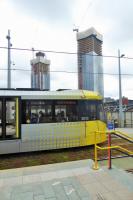
Deansgate-Castlefield: High rise buildings under construction near Deansgate-Castlefield Metrolink stop as Tram 3053 departs towards Cornbrook with a service for East Didsbury on 27th March 2018.
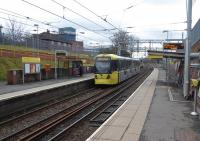
Trafford Bar [Tram]: An Altrincham bound service pulls away from busy Trafford Bar station in March 2018. The doors on Metrolink trams are set very high because the system had its origins on two old railway lines. I believe they are unique on street running trams in the UK if not further afield.

Deansgate: DB 67015 propels the 1307hrs Holyhead to Manchester Piccadilly service through Deansgate station on 27th March 2018.
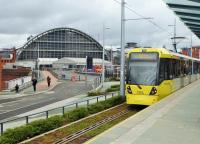
Deansgate-Castlefield [Tram]: Metrolink 3100 pauses at the Deansgate-Castlefield stop on its way to the city centre, with the former Manchester Central train shed prominent in the background. 27th March 2018.
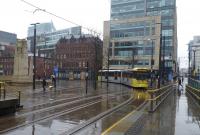
St Peters Square: Metrolink 3031 swings round the corner from the new Second City Crossing line and into the greatly enlarged St Peters Square tram stop on a wet 27th March 2018. This was a Rochdale to East Disdbury service.
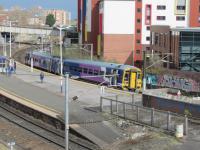
Manors: Manors station is not what it once was when it had nine platforms and was an interchange. It lost its trains on the North Tyneside loop to the Metro station. This is geographically nearby but just you try walking between them. The area was wrecked by sixties planners although the inevitable student flats have more recently brought some colour and life, but that is relative. A Northern service from Morpeth calls on 27 March 2019. A few hundred yards will see it at Newcastle Central.
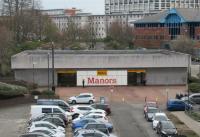
Manors [Metro]: The 'Station That Looks Most Like a Bunker' award goes to: Manors Metro. A garden roof might improve things; demolition certainly would. At least the name sign is friendly to the visually impaired.
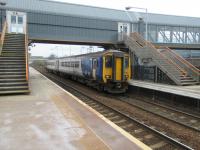
Metrocentre: A terminating service from Newcastle at Metrocentre which is also known as MetroCentre, and, per the station signs, Metro Centre. These hourly trains supplement the Hexham and Carlisle trains which also call here. Strangely perhaps they run non-stop on the way out but call at the intermediate station of Dunston on the way back.
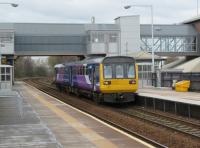
Metrocentre: A Class 142 re-enters Metrocentre station to form the returning shuttle service to Newcastle. Class 142s are a novel experience for me, but I can understand why regular commuters view them unfavourably. The doors (of which they seem to be one short each side) open like a bus doors, and funnily enough. ... If that is the platform lighting they chose I'm wondering what on earth was rejected.

Morpeth: A doubled-up CrossCountry services hurries north through Morpeth on 27 March. Meanwhile the station building is receiving consdierable attention.

Morpeth: On 27 March 2019 a Northern Class 158 re-enters Morpeth station after reversing in the line to the right of the signal box. It will return to Newcastle calling at Cramlington and Manors. You will have to take my word for that as the information screens are displaying gibberish. On these trains there is an odd division of labour among the digital announcements as a male voice does the boring safety stuff and a woman announces the stations.
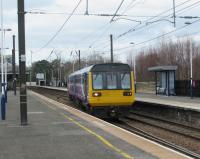
Morpeth: Morpeth on 27 March 2019 and a terminated service from Newcastle crosses over and heads for the start of the Bedlington line where it will change ends and re-enter the station to return to Newcastle. Class 142s are a novelty for an easily-pleased visiting Scot, though I can see how they'd not be so much fun if you were commuting on them every day. They really are like something come across in a poorer country - thirty years ago.
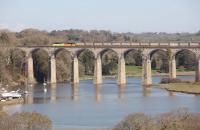
St Germans Viaduct: 70816 seen with the Aberthaw to Moorswater cement crossing St Germans viaduct on a lovely spring morning. All this traffic was lost when the Moorswater distribution plant shut. All cement for Devon and Cornwall must now travel by road.

West of Scotland Signalling Centre: Network Rail is appealing for former signallers and controllers who can help to keep Scotland’s Railway running during the COVID-19 lockdown. The rail industry wants former signallers, train running and incident controllers and ECRO colleagues to return to the industry to boost numbers in these key posts. Full refresher training will be provided and former colleagues will be able to help play a vital role in keeping the network open. Scotland’s Railway is working around-the-clock to keep NHS staff, other key workers and essential freight supplies on the move across the country. All signal boxes and control centres are currently operating normally and the network is running well, but Network Rail wants to build a contingency pool of experienced people ready to step in if current staff have to self-isolate in the weeks ahead.
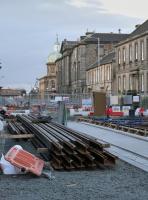
The Shore [Tram]: View of the Newhaven tram extension works, looking north along Constitution Street close to the intersection with Bernard Street / Baltic Street, on 27 March 2021.
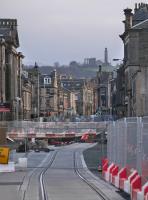
The Shore [Tram]: Tram works in progress in Constitution Street, looking south with Calton Hill in the distance, on 27 March 2021.
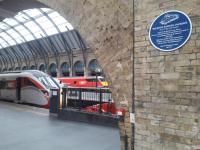
Kings Cross: This blue plaque at Kings Cross was unveiled in October 2021 and is dedicated to Wilston Samuel Jackson, the first black train driver on British Railways. Mr Jackson died in 2018 at the age of 91 and his family attended the unveiling of the plaque. In this March 2022 view an Azuma and a Class 91 IC225 set are in the platforms.
Events
Events from the chronology which occured on this day. This generally lists events before 1995, the creation of the website.
News
These are old news items which which occured on this day. This generally lists events after 1995, the creation of the website.
| Year | Companies | Description |
|---|---|---|
| 2004 | Conductor loses job claim after closing doors on passenger [Scotsman] | A TRAIN conductor who allowed a passenger off at a station to get cash to buy a ticket, then permitted the train to leave without him, has lost his unfair sacking claim. |
| 2006 | Railway return deadline defended [BBC News] | Transport Minister Tavish Scott has defended the new timetable for reopening the Waverley line. He said the guarantee of opening by 2011 and the commitment of £155m towards costs gave as much clarity as possible to the project. |
| 2008 | Bus swap driver hits rail bridge [BBC News Article] | A bus loses most of its roof on a bridge after the driver forgets he has switched to a double decker. |
| 2009 | Launch of the ^Rails to Grantown^ appeal | Nearly eight years after the re-opening of the original Highland Main line between Boat of Garten and Broomhill and eighteen months after reaching the River Dulnain, the Strathspey Railway Charitable Trust launched the ^Rails to Grantown^ appeal at Broomhill Station, near Dulnain Bridge yesterday. Local and national politicians as well as leaders of the many organisations that are giving support to the project attended. The intention of the appeal is to raise at least £182,000 in the current year, part of the estimated £5M it will cost to restore a train service to Grantown-on-Spey. Braeriach, a 0-6-0 tank locomotive formerly on the Weymss Private Railway, pulling the LMS Inspection Officers Saloon heralded the launch of the appeal event at noon. During the afternoon, this train took guests down some of the new track already laid towards Grantown. [With thanks to Sue Davies] |
| 2009 | Anger as rail station locked [Evening News] | RAIL passengers travelling from Linlithgow Station were late for work yesterday when they arrived to find the station locked |
| 2010 | Rails to Grantown [Press and Journal] | PASSENGERS yesterday took a journey along a stretch of railway that has not been used since swingeing rail cuts in the 1960s. [From Sue Davies] |
| 2011 | Anger at East Coast rail chaos [BBC News] | Train passengers left stranded by signalling problems on the East Coast main line have complained of being left to fend for themselves. |
| 2012 | First of ScotRail’s refurbished trains back on the rails [Rail.c0] | Four ScotRail trains serving key cities have returned to service after a refurbishment under a £6 million enhancement programme. They are the first of 33 trains to receive interior and exterior makeovers in a project due to be completed in December next year. All the work is being carried out at Railcare Limited’s depot in Springburn, Glasgow – which employed 12 more people for the contract. The project, aimed at enhancing passenger comfort, takes place during routine maintenance cycles. It includes new carpets and toilet flooring and also involves rebranding the Class 170 trains in the new “ScotRail, Scotland’s Railway” unified livery. Two of the fleet, which previously had Standard Class seats only, have now been fitted with new First Class compartments. All the trains run on Aberdeen, Edinburgh, Glasgow and Inverness routes. |
| 2013 | Beeching was right says Influential Railway Panel [Rail.co] | The Campaign for Better Transport (CBT) organised two debates to mark the 50th anniversary of the what has become known as the infamous Beeching ‘Reshaping The Railways’ report. This was published on March 27 1963 and led to wholesale rail closures - and arguably the start of the modern railway. For years, Dr. Beeching was reviled as the man who nearly destroyed the railways – but did he? The first debate was at London’s Science Museum and the second at The National Railway Museum in York to be held on March 27, the exact anniversary of the report. |
| 2013 | What was Beeching^s worst railway cut? [BBC News] | It is 50 years since Dr Richard Beeching^s report on British Railways which led to hundreds of stations and 650 miles of railway line being closed in Scotland. The axing of the 98-mile Waverley Route from Edinburgh to Carlisle was the worst of all the Beeching cuts, according to author and railway expert David Spaven. The closure left the Scottish Borders as the only region of Britain without a train service and Hawick, 56 miles from Edinburgh and 42 miles from Carlisle, as the largest town farthest from a railway station. |
| 2013 | David Spaven: On track for the rebirth of Waverley Line from Borders to city [Evening News] | Once Dr Richard Beeching had unveiled his infamous report on The Reshaping of British Railways, 50 years ago today, the country’s rail network would never again be the same. But – with hindsight – does he really deserve his reputation as an axeman or was he simply doing a job which had to be done? |
| 2013 | Snowdon Mountain Railway workers battle to reopen snow-hit track [BBC News] | Workers are battling to reopen Snowdon Mountain Railway after it was hit by 30ft (9.1m) snow drifts. Two excavators are being used to clear the 4.7 mile (7.5km) track. It is unlikely passengers will be able to travel to the summit over Easter but it is hoped the train will be running to stops three quarters of the way up. The railway resumed operations from Llanberis last week after the winter break but they were suspended within days after heavy snow on the mountain. Alan Kendall, general manager of Snowdon Mountain Railway, said: ^It^s the worst I^ve experienced in the 11 years I^ve been here. |
| 2014 | New display to open chronicling the industrial ‘railway corridor’ [News Guardian] | Stephenson Railway Musueum will this weekend launch a new permanent display that chronicles the indistrial ‘railway corridor’ from Backworth Colliery to the coal staithes on the river Tyne. All Our Stories: Our Railway in Years Gone By is a Heritage Lottery Fund supported project led by the North Tyneside Steam Railway Association (NTSRA). |
| 2014 | Crossrail to be extended to Reading [Railnews] | THE Crossrail network is being extended from Maidenhead to Reading. The announcement from Transport for London and the Department for Transport has confirmed years of speculation that Maidenhead was not the ideal western terminus, particularly as Reading is a key hub on the Great Western network. The major remodelling still in progress at Reading was planned with such an extension in mind. [From Crinan Dunbar] |
| 2015 | G&W completes Freightliner acquisition [IRJ] | GENESEE & Wyoming (G&W) confirmed on March 25 that it has completed the £492m acquisition of approximately 94% of Freightliner Group, Britain, from Arcapita and other shareholders, plus approximately £19m of net debt and capitalised leases. [From Richard Buckby] |
| 2015 | High Cumbria winds ^blew freight container off train^ [BBC News] | High winds blew a container off a freight train travelling at 75mph (120km/h), investigators have said. The empty 30ft (9m) cargo crashed through trees and a wall on an embankment near Scout Green, Cumbria. No-one was injured but the Rail Accident Investigation Branch (RAIB) said the potential for more serious consequences was evident. There were 62mph (99km/h) cross winds when the container fell on on 7 March, investigators said. |
| 2015 | Abellio giving cause for concern [Scotsman] | SCOTRAIL’S new operator is in danger of a having shaky start to its tenure, writes Alastair Dalton. Alarm bells are going off in my head about the Scottish taxpayer’s biggest contractor – and it hasn’t even officially started the job yet. Dutch firm Abellio takes control of ScotRail on Wednesday, funded by the Scottish Government to the tune of £2.5 billion over the next decade. |
| 2017 | Stagecoach lose South West Trains franchise [ITV News] | The Government has just announced major new plans to improve rail services in the south. In a shock move current owner Stagecoach will be replaced with Great Western Railway owner First Group. |
| 2019 | Great Northern rolls out £240 million fleet of new trains [ITV News] | A 240 million fleet of new trains have entered service to replace mainland Britains oldest electric rail fleet. Great Northern deployed the first two of its new Siemens Class 717 trains on routes between Moorgate and Hertfordshire on Monday. |
| 2019 | New trains crisis: ORR demands co-operation to ensure progress of new fleets [RAIL] | Nine new train fleets delayed so far while ORR urges industry to work together to overcome the problems |
| 2019 | More trains, quicker journey times and improved station lengths all part of Highland railway improvements [Press and Journal] | Network Rail has completed a £57 million upgrade on the Highland main line between Inverness and Perth. |
| 2019 | ScotRail seeks compensation for delays to new trains [BBC News] | The train operator reveals it is looking to recoup some of the millions spent on delayed rolling stock. |
| 2019 | £56bn HS2 rail project under fire for using taxpayers^ money to hire two consultancy firms [Daily Mail] | Bosses behind the construction of the HS2 rail line have been criticised over plans to pay two consultancy firms £225million. The high-speed line has already cost £4.1billion. |
| 2019 | Deutsche Bahn to sell UK rail and bus operator Arriva [The Guardian] | German state rail firm exploring options for a sale or possible public flotation. The transport group Arriva, which runs UK rail franchises including Northern and the London Overground as well as buses around the country, is to be put up for sale by its owner, Deutsche Bahn. The German state rail operator has revived plans for a sell-off or possible public flotation for the UK-based company. |
| 2020 | Network Rail supports army to deliver vital medical face masks to NHS frontline [Network Rail] | Railway workers have driven hundreds of miles through the night to deliver two lorry loads of protective medical face masks for frontline workers in the NHS. |
| 2020 | ^Gob-smacking^ vision for future UK transport [BBC News] | Public transport and active travel will be the ^natural first choice^, the Transport Secretary says. |
| 2020 | Glasgow SPT Subway temporarily axes Inner Circle amid coronavirus pandemic [Evening Times] | Glasgow^s Subway system will reduce to one circle only as of tomorrow. |
| 2020 | Key railway workers enable 370,000 tonnes of vital food, medicine and other supplies to be moved in a week [Network Rail] | This week alone key workers from Network Rail have enabled more than 370,000 tonnes of freight to be moved between west London and Cornwall and into and across Wales to support the economy, the NHS, petrol at the pumps and food in shops. |
| 2020 | Scotlands Railway appeals for former signallers to help keep vital services moving [Network Rail] | Network Rail is appealing for former signallers and controllers who can help to keep Scotland^s Railway running during the COVID-19 lockdown. |
| 2020 | Support for key workers with timetable changes [ScotRail] | Services running across Scotlands Railway will be further revised from Monday, 30 March, as we refine the arrangements we have in place to keep key workers moving. Following Scottish Government guidance that advises people against all non-essential travel, ScotRail has focused changes in the areas of the country where people need it most. |
